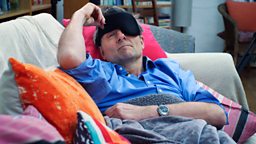Can you use your mind to strengthen your body?
The idea that we can get fitter and stronger from the comfort of our own sofa sounds too good to be true, but there’s real evidence we can enhance our physical performance without moving a muscle.
Research has found that “motor imagery” is a technique that really works. It’s used by top athletes but you can try it too. It can help you get stronger, improve muscle function, and even help you recover after an injury. In his podcast, Just One Thing, Dr Michael Mosley takes a close look at the science behind this incredible technique – and explains how you can use it.

Michael Mosley investigates whether thinking can increase muscle strength
Can thinking about exercise enhance our physical performance?
Imagining your way to sporting success
The latest research shows that combining motor imagery with physical practice is a more efficient way to become a stronger or a better athlete than physical practice alone. Put simply, we are creating an experience in our mind. To practise it effectively, we should visualise the flow and pace of our movements, and in target-oriented sports, the outcome we want to achieve.

The benefits of visualisation were first demonstrated back in 1899, and since then, it’s been effective in a range of activities – from rugby to tennis, and even helping us run faster. But it’s not just skills that can improve with the power of thought. Many of us would like to get stronger, but lifting weights can feel like a slog when you’re a beginner. Motor imagery may come in handy here too, as it’s actually been shown to improve our muscular strength.
Think yourself stronger
The idea that you could improve strength with your mind came from studies in the 1990s. In one study, researchers from Louisiana State University asked a group of women to imagine extending their knees and contracting their quadricep muscles for five seconds. They were asked to make sure that they didn't actually do any contractions. By the end of the study, their quadriceps muscle strength had increased by an impressive 12.6%, even though there was no evidence their muscles got any bigger. For Just One Thing, Michael Mosley turned to cognitive psychologist Dr Helen O’Shea to find out what else could be going on.
Mind over matter
“When you're looking at motor imagery, it's a cognitive technique – you don't expect something like strength gain,” says Dr Helen O’Shea. “When we started studying this area, we found that motor imagery didn't just improve our movement skill, but it actually altered the way our brain operates and the way that our physiology works.” They were astonished to find that motor imagery was not just involving the conscious parts of our brain – the parts that are involved in thought – but also the motor networks responsible for executing the activity. It was having effects that are astonishingly similar to the effects of physical activity.
Motor imagery can increase our strength by fine tuning the drive towards those musclesDr Helen O’Shea
So how does it work? “Motor imagery can increase our strength by fine tuning the drive towards those muscles,” Dr O’Shea explains. “We can use motor imagery to really prime our motor systems so that when we come to physically execute the movement, we're already fine-tuned, and we're ready to go.”
Motor imagery can teach us to stimulate our muscles and body in a more specific and efficient way, so we don’t waste energy. That’s how the participants of the Louisiana State University study were able to lift heavier weights with the power of thought alone. It may seem unconventional, but it’s a fabulous way of honing our response, and perfecting our technique.
What else is it used for?
Motor imagery is used right across a range of activities. Experts have been able to deploy the technique beyond sport. “Our research tells us that this is really effective in musicians, in surgeons, and it's used for motor rehabilitation. And there's a larger body of research that demonstrates that,” says Dr O’Shea.
Can I try it myself and what’s the best way to do it?
If we want the best results, Dr O’Shea advises we mix it in with physical practice. “We need physical movement to give us that sensory knowledge of the effects of our movements – we don't know what the movement is going to feel like,” she says.

We also really need to try and feel our body perform the movement from the first-person perspective, so “make sure you keep the same flow and pace as when you physically execute that action,” Dr O’Shea says. In the best-case scenario, she advises that you would practise the mental imagery in the location where you're going to physically perform the action. In Just One Thing, we asked our volunteer Tom to improve his goal-shooting skills with motor imagery while in his back garden, with his football kit on, imagining kicking a ball into the net, without touching the ball.
If you’re hoping to perfect that tennis serve too, holding the tennis racket or actually going to the tennis court will enhance the effects of motor imagery too. Yes, you may get some strange looks, but it will really help you visualise it. “It's not absolutely necessary. But there is evidence there to say that it helps,” says Dr O’Shea.
Whether you’re perfecting that push-up, or trying to shave seconds from your time – why not give it a try? You just don't want to do more than 20 minutes of motor imagery at a time as putting yourself through the virtual paces can still cause fatigue as well!
To learn more, listen to Just One Thing - with Michael Mosley: Think Yourself Stronger
More from Radio 4
-

Just One Thing: Think Yourself Stronger
Michael discovers how to increase his strength without moving a muscle – just using the power of the mind.
-

The Curious Cases of Rutherford and Fry: The Painless Heart
Why does my heart not ache after exercise? asks listener Keith. Rutherford and Fry explore how and why heart muscle cells are special.
-

How to reset your brain with your breathing
How can controlling your breathing combat stress and make you mentally sharper?
-

Made of Stronger Stuff: T cells
Kimberley Wilson and Xand van Tulleken find out how our immune system can be reprogrammed.
















































